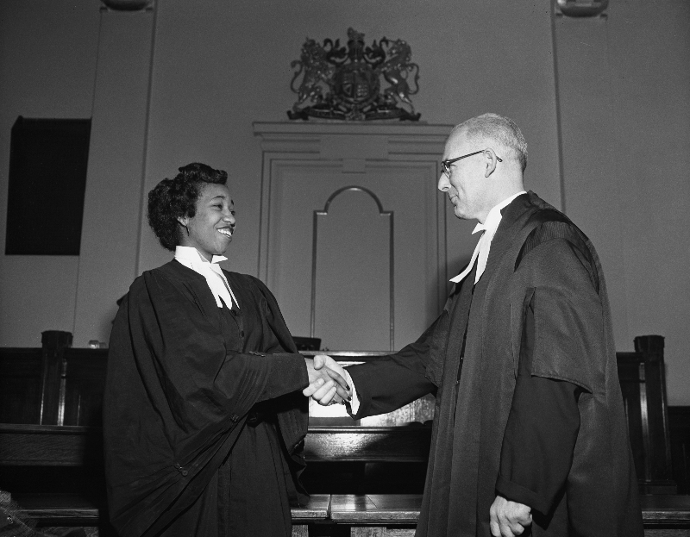
Violet King shakes hands with E.J. McCormick, with whom she articled. (June, 1954). Photographer/Illustrator: De Lorme, Jack, Calgary, Alberta.
VIOLET KING: A DAUNTLESS YOUNG WOMAN
U OF A Law 1953
First Black person to graduate from U of A Law
First Black Woman Lawyer in Canada
There are many Lists of Firsts in Canadian law, but few of them have recognized the extraordinary achievement of Violet King in becoming the first Black woman lawyer in Canada. This article on Violet King is co-authored by Rachel K. Bailie, and Professor (now-Interim Dean of the Faculty of Law) David Percy.
David Percy first learned about Violet King a few years ago when she was celebrated during Black History Month in Alberta. He was astonished to learn that the first black woman lawyer in Canada was a graduate of this Law School. Her story was intriguing on grounds of both gender and race. After all, the 1950s were not a good time for women who sought legal careers. An examination of the class pictures shows a significant number of women law graduates before the Second World War, but the number of women graduates declined significantly in the 1950s. When Violet King entered law school, there were only 3 women in a student body of 142 and she was the only woman in her graduating class. While a graduate student at the University of Virginia, David Percy knew Elaine Jones, the first African American woman student to graduate from Virginia Law School in 1970. It was surprising and rather heartening to learn that Alberta was 27 years ahead of Virginia in this respect.
Violet King's grandparents had moved to Keystone, (now Bretton), Alberta from Oklahoma in 1911, having entered Canada as a result of the federal government's campaign to attract farmers from the United States. The government had not anticipated that their campaign would encourage black farmers to enter the country and it quickly began to take active steps to discourage further black immigration. After introducing, but never bring into force, on order prohibiting immigration by members of "the Negro race", the government took steps to discourage settlement by black farmers and by 1912, it had effectively come to an end. Violet King's parents, John and Stella King, moved to Calgary in 1919. They lived in the community of Hillhurst-Sunnyside in Calgary, where John worked as a sleeping car porter for the CPR and Stella worked as a seamstress. Violet was born in 1929 and educated at Crescent Heights High School. She was active in high school life and became President of the Girls Association in grade 12. Unusually for those times, her Grade 12 photograph was accompanied by the caption "Violet wants to be a criminal lawyer."
Violet King began her studies at the University of Alberta in 1948 and became a very prominent member of the student body. She was a member of the Blue Stocking Club, a discussion group for women with an emphasis on history and public affairs. She was Vice-President of the Students Union and the representative of the Students' Union to the National Federation of Canadian University students. She was selected class historian for her final year of undergraduate studies and served as the Alberta representative to the International Student Services Conference in Hamilton in 1952. In addition, she taught classical piano lessons throughout her years in Edmonton in order to finance her education. Violet's many activities and contributions to student life were recognized in 1952, when she was one of only four students to receive an Executive "A" gold ring at Color Night, the annual celebration of student contributions to the University. The stature of this award is demonstrated by the identity of the other 1952 recipients. They were Peter Lougheed, a future Premier of Alberta and the subject of an earlier story in the series, Ivan Head, a future member of the Faculties of Law at Alberta and UBC and special advisor to Prime Minister Pierre Trudeau, and Garth Fryett, a leading member of the Alberta bar and a prominent Edmonton legal practitioner.
Violet King received her LL.B degree in 1953 and fulfilled her high school ambition by articling to Edward J. McCormick, Q.C., a prominent Calgary criminal trial lawyer. Her call to the bar, on June 2, 1954, was the only time that she entered the media spotlight. Her admission was front-page news in both The Albertan and the Edmonton Journal and the subject of a large article and photograph in the Calgary Herald. Both Calgary newspapers described the day as "a milestone in Canadian history". The journalists were perhaps unusually perceptive, because just over two weeks earlier United States Supreme Court had issued its decision in Brown v. Board of Education. Later in the month, Violet King received a significant recognition from the International Brotherhood of Sleeping Car Porters. The President of the organization, A. Philip Randolph travelled from New York, along with a second vice president from Detroit, Bennie Smith, to make a special presentation to Violet King at a social gathering in Calgary.
In common with the majority of Edward McCormick's articling students over the years, she did not remain with his office. She is reported to have acted as treasurer for a local labour union. Perhaps she expressed a sense of personal frustration a few months later when she was a guest speaker at a dinner in Calgary. She commented: "It is too bad that a Japanese, Chinese or colored girl has to outshine others to secure a position" and expressed the hope that in future issues of race and gender would be subordinate to a candidate's ability to do a job.
Based on subsequent newspaper articles, it appears that Violet continued to practise criminal law, most likely worked at a firm headed by another legendary Calgary criminal lawyer and future appellate justice, A.M. (Milt) Harradence. In later newspaper interviews, Violet spoke highly of her experiences working in criminal law and said she would happily have continued to practise if it were not for a particular opportunity that became available with the federal Department of Citizenship and Immigration.
Violet King changed her status to become a non-practising member of the Law Society in April, 1956. The role with CIC involved travelling around Canada to meet with the leaders of different service and community organizations. Violet cited her legal education and experience as wonderful training for the role and her client work as helpful for working with the leaders of the organizations with whom she spoke.
It appears that Violet's social and community involvement from her earlier years carried forward and shaped her career path and choices. Following her time in Ottawa, Violet moved to the United States in 1963 to take on the role of associate general secretary of the Newark, New Jersey, YW-YMCA. This role focused on assisting Black applicants in their employment searches for which she received the Special Mott Fellowship from the YMCA. In 1969, she moved to the Chicago YMCA where she was the director of manpower, planning, and staff development for the Chicago YMCA. In 1976, she became the first woman named to a senior management position with the American national YMCA organization. She is reported to have died of cancer in Chicago in 1981 or 1982.
It was difficult for all women to enter the legal profession in the 1950's and 1960's and it must have been particularly difficult for women who were also members of a racial minority. The few historical sources that are available suggest that Violet King was a remarkable woman. It is the Faculty's pleasure to provide this belated recognition of her achievements.
~ Rachel K Bailie and David R. Percy
Additional Information
-
Rachel Bailie's article on Violet King, "Minority of One: Violet King's Entry to the Legal Profession" was published in the Canadian Journal of Women and the Law in the Fall of 2012. It is available via subscription: http://utpjournals.metapress.com/content/3j22t445n7762231/?p=ffdb9ef7fbc54686b5d6e28399edde22&pi=1
 Railway porters presentation to Violet King, Calgary, Alberta (June, 1954). Photographer: De Lorme, Jack, Calgary, Alberta.
Railway porters presentation to Violet King, Calgary, Alberta (June, 1954). Photographer: De Lorme, Jack, Calgary, Alberta.Editor's Note - Feb 19, 2020: This story originally appeared on the UAlberta Law website on December 24, 2012. It was posted on February 10, 2017 to the University of Alberta's Canada 150 website as part of the Nation Builders series. Rachel Bailie - co-author of the story - is also the author of a paper on Violet King - Minority of One: Violet King's Entry to the Legal Profession - which was published in the Canadian Journal of Women and the Law. The paper can be found here. UAlberta Law's Professor Shannon O'Byrne and Sandra Petersson, executive director of the Alberta Law Reform Institute, supervised Ms. Bailie's independent research project on Ms. King.